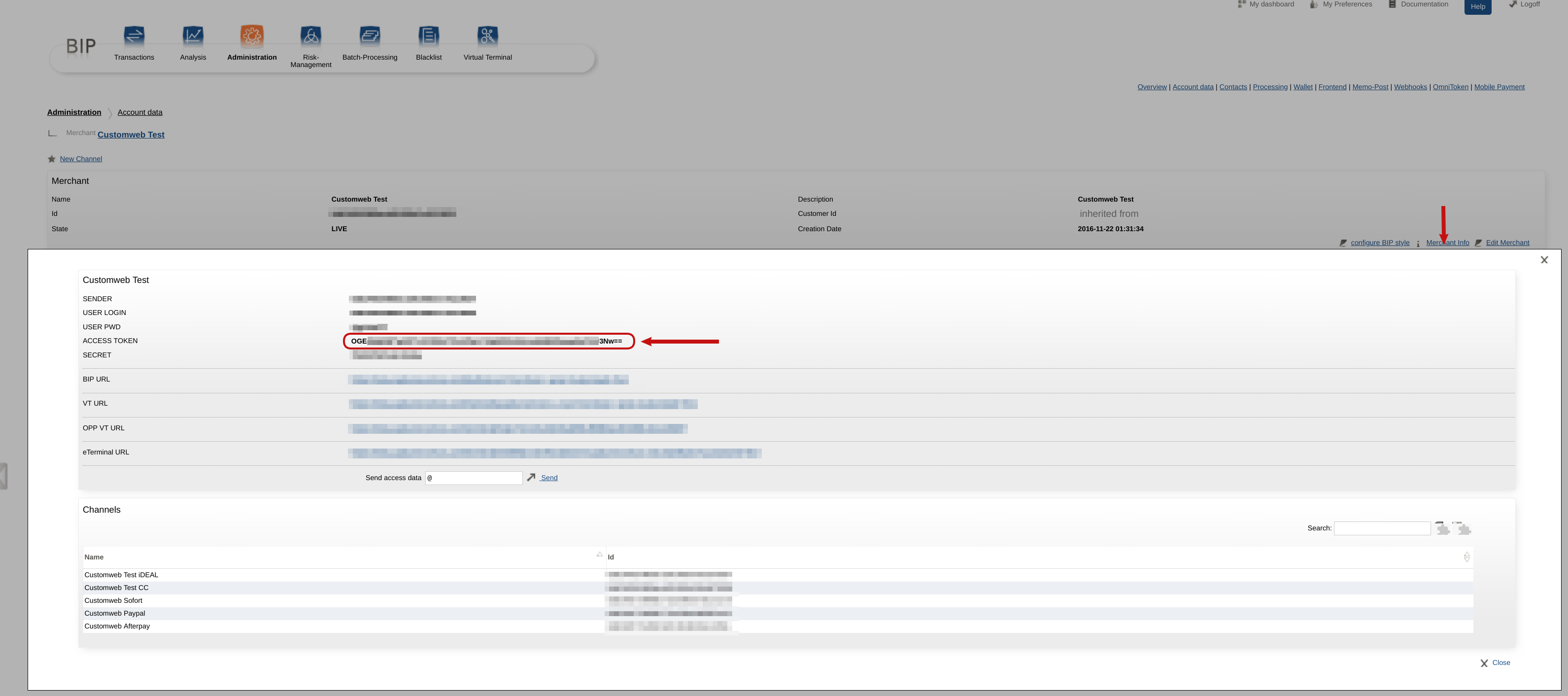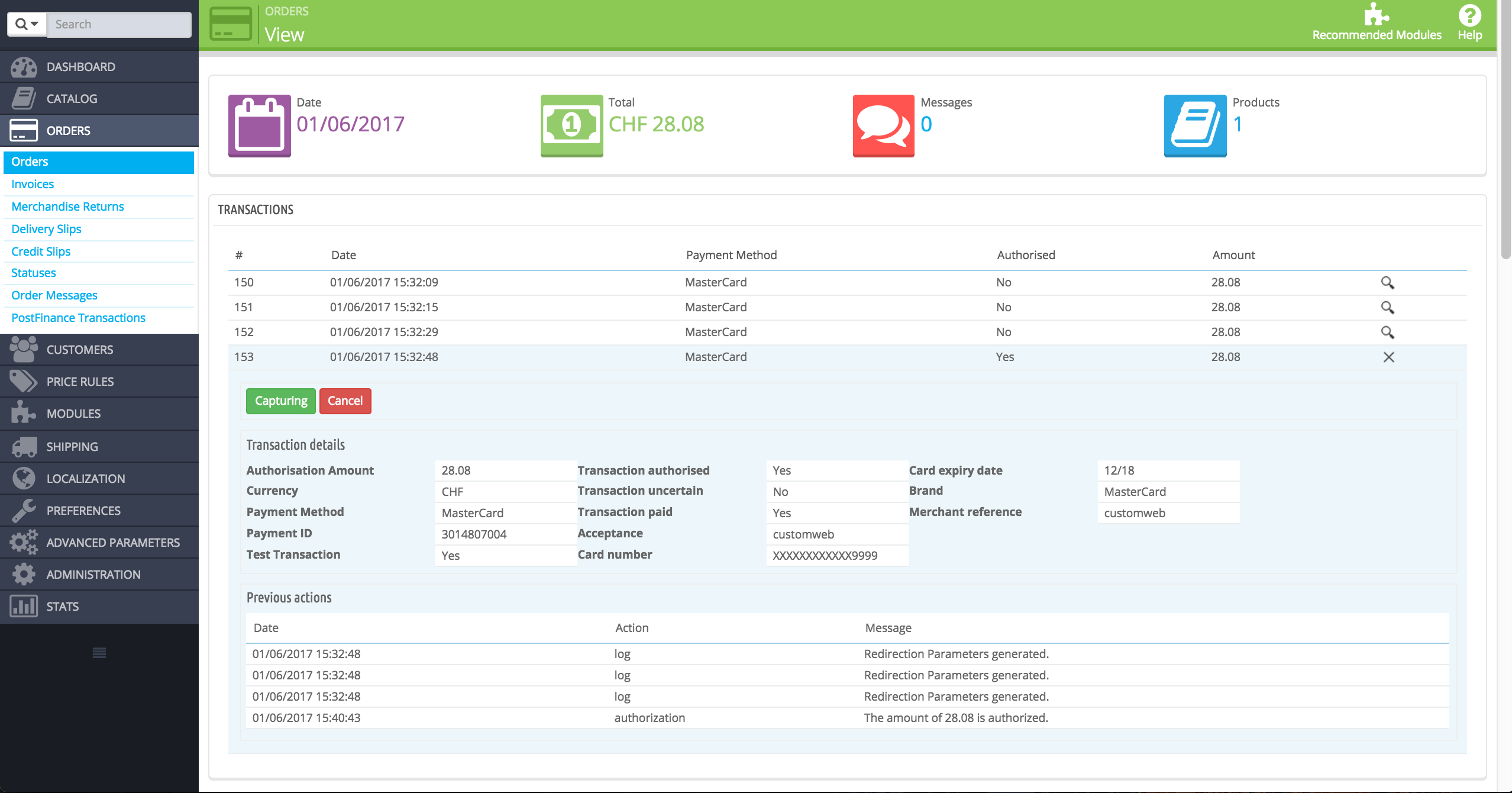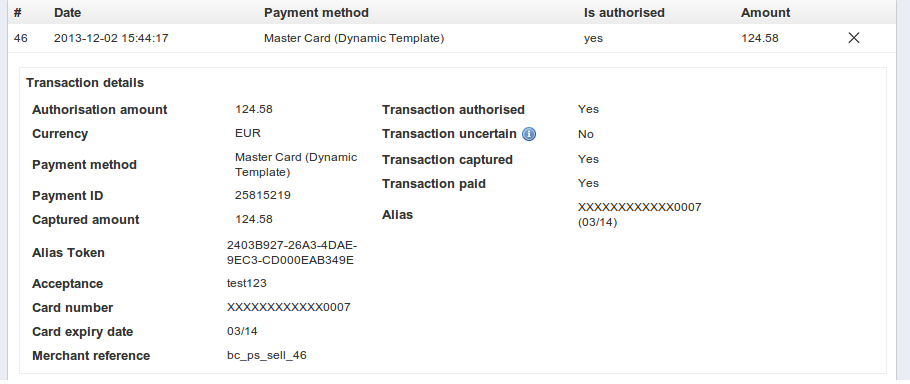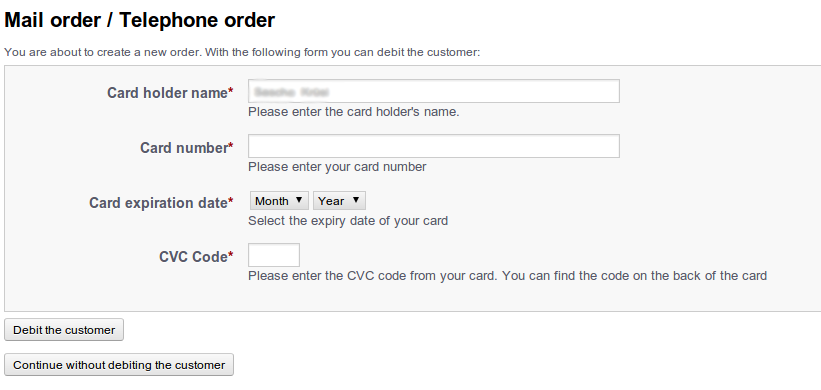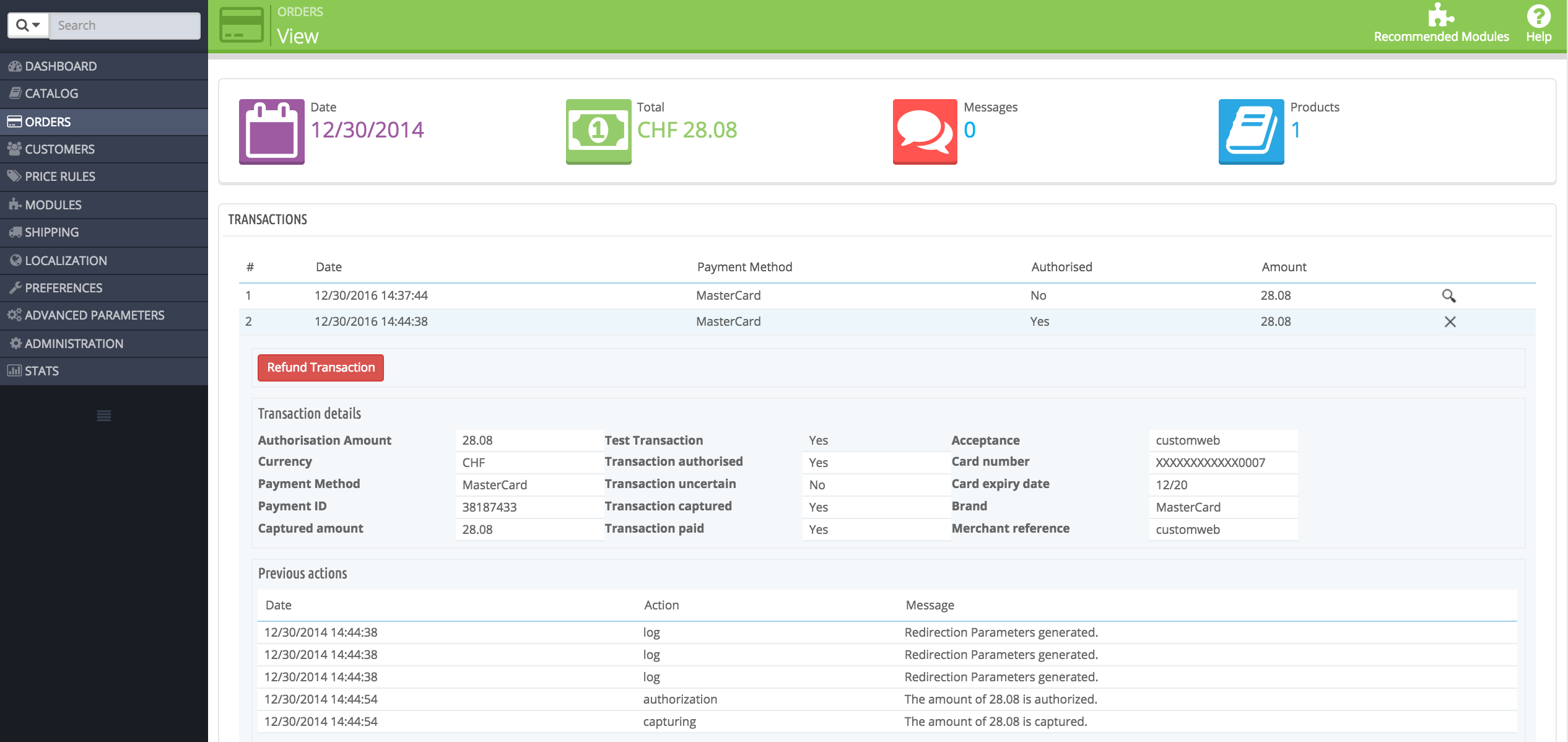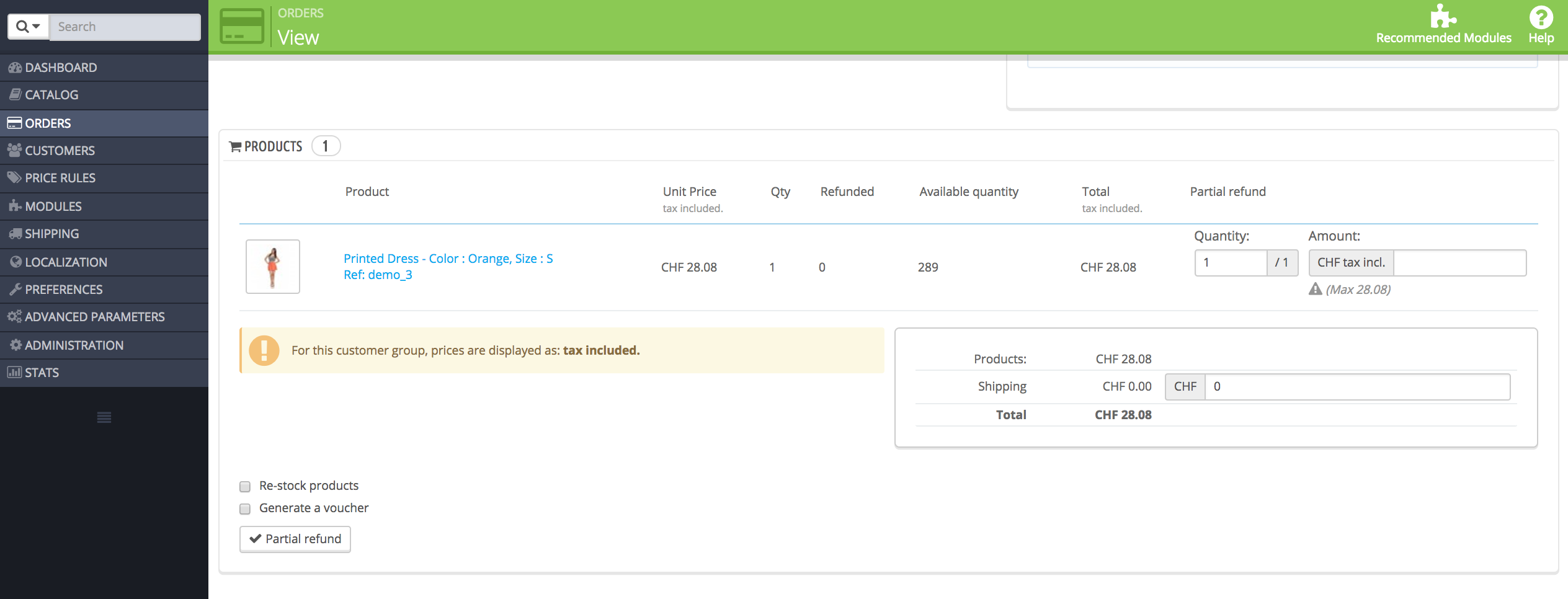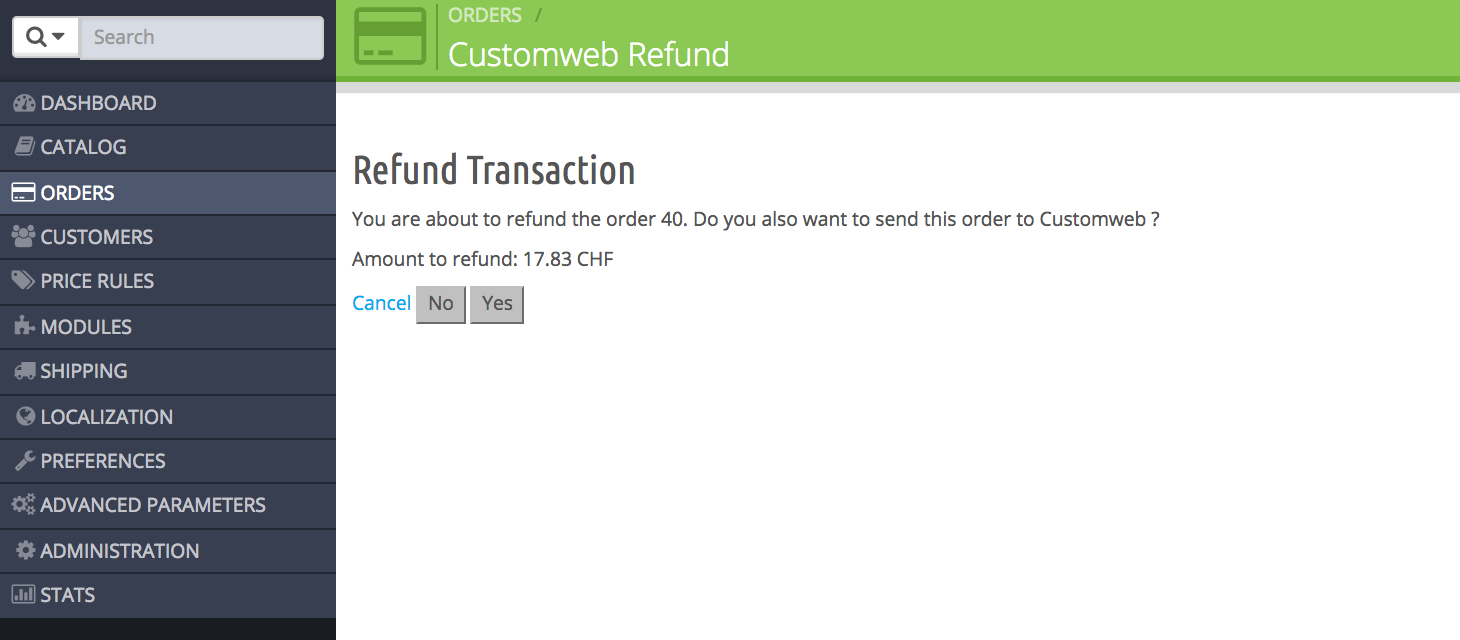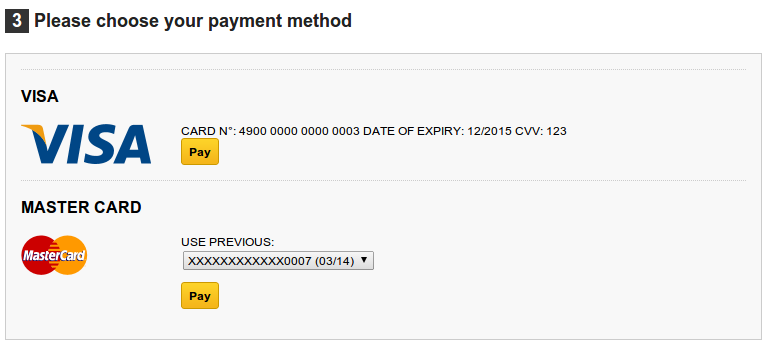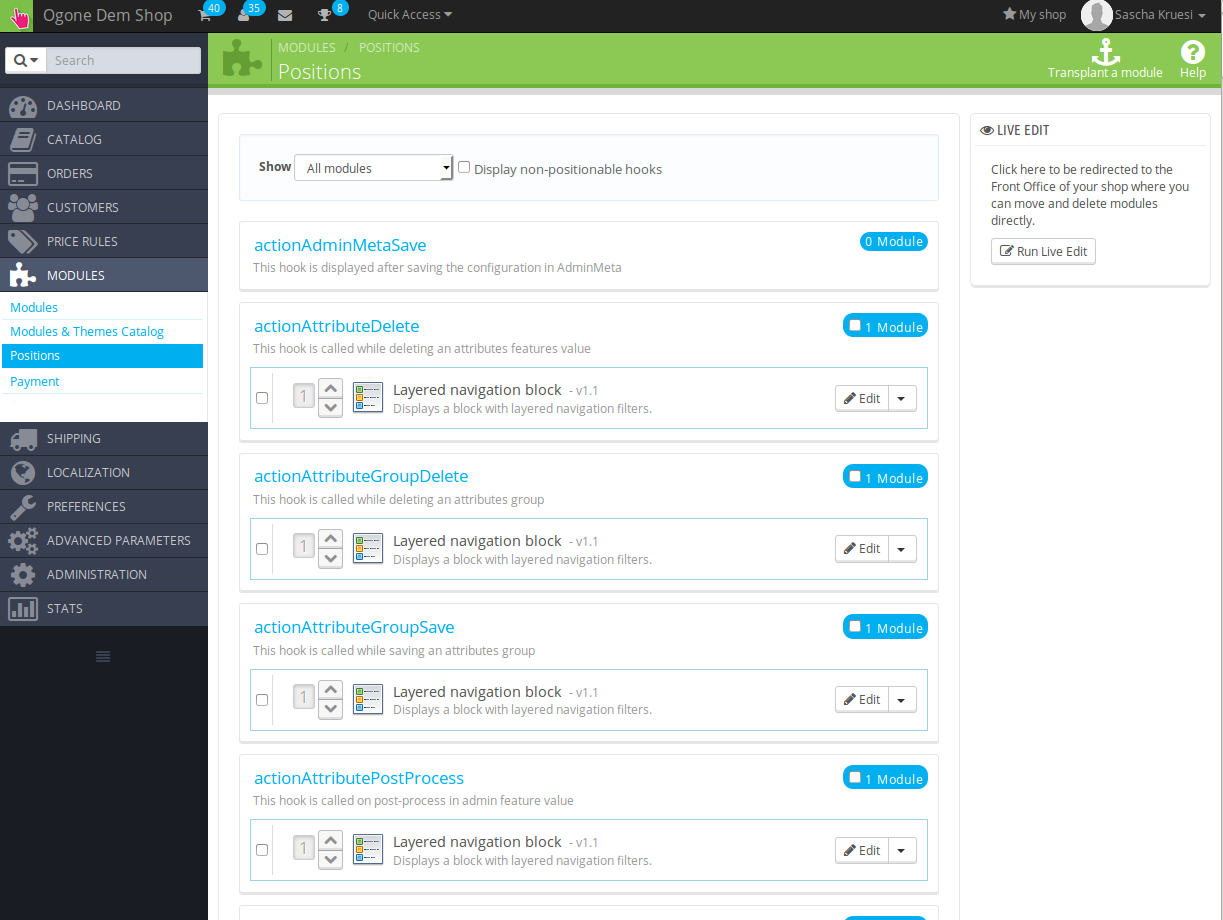1Introduction
This manual explains the installation, configuration and usage of the payment module for PrestaShop and Open Payment Platform.
Before beginning with the installation, please make sure that you are in possession of all necessary data:
- User name and password for the login to the backend of Open Payment Platform
- PrestaShop payment module by sellxed.com/shop
- Access data to your server and shop
In case you don't yet have a contract with Open Payment Platform, you can acquire it directly through us.
Note that you must use at least PHP version 5.6 for our plugins. PHP 8 or higher is currently not supported.
1.1Installation Procedure
In this document you will find all important information for the installation of the module. It is important that you strictly follow the checklist. Only by doing so a secure usage in correspondence with all security regulations can be guaranteed.
- Configuration of the test environment by means of the integration data from Open Payment Platform. These can be found on the test platform under
- Configuration of the basic settings of the payment module
- Configuration of the payment methods
- Carrying out of a test purchase by means of the attached test data at the end of this document
- If the test was successful, you can configure the live data in your shop. Log into the live environment with the obtained access data under:
Our payment plugins should have per default the correct settings for most of our customers' preferences. That means once you have entered the required credentials in the plugin configuration to connect your account to your website, the plugin should be fully operational. Should you be willing to receive detailed information on a setting you do not know, you may contact our support team who will be able to assist you further.
Our support team is at your disposal during regular business hours at: http://www.sellxed.com/support. Furthermore, you have the option of ordering our installation service. We will make sure the plugin is installed correctly in your shop: http://www.sellxed.com/shop/de/integration-und-installation.html
In order to test the module, any kind of directory protection or IP blocking on your server must be deactivated. This is crucial as otherwise the payment feedback of Open Payment Platform might not get through to the shop.
1.2System Requirements
In general, the plugin has the same system requirements as PrestaShop. Below you can find the most important requirements of the plugin:- PHP Version: 5.4.x or higher
- PrestaShop Version: 1.6.x or higher
- OpenSSL: Current version with support for TLS 1.2 or higher.
- fsockopen: The PHP function fsockopen must be enabled. The plugin must be able to connect to external systems over the Internet.
- PHP Functions: All common PHP functions must be enabled.
2Configuration
2.1Basic configuration of the main module
The access data for the test environment () is provided to you by Open Payment Platform.
Navigate to the main module in your Shop and fill in the following access data:
- Authorization Bearer Token (Access Token)
- Entity ID (CHANNEL ID )
- The User ID and Password are depreacted and not required anymore, use the new Authorization Bearer Token instead.
- You no longer need the parameter Security Sender and Security and Hash Secret for the integration. You can simply ignore this entry.
- The boxes for "Security Hash" and "Security Hash Secret" can be left empty unless your Payment Service Provider instructs you to do otherwise
You also have more entry options. For example the Custom Parameters. In principle you leave these blank unlessOpen Payment Platform requires you to do otherwise.
2.2Configuration of the Payment Methods
In order to activate the payment methods and to change other payment specific settings, navigate to the settings. (A description as to where to find these settings is listed here hier)
In the configuration of the payment methods you can define which Entity ID (Channel ID) should be used for which amount. This allows you to use a non-3D Secure Channel in case of small figures. In order for you to be able to set up and get the corresponding contract please contactOpen Payment Platform.
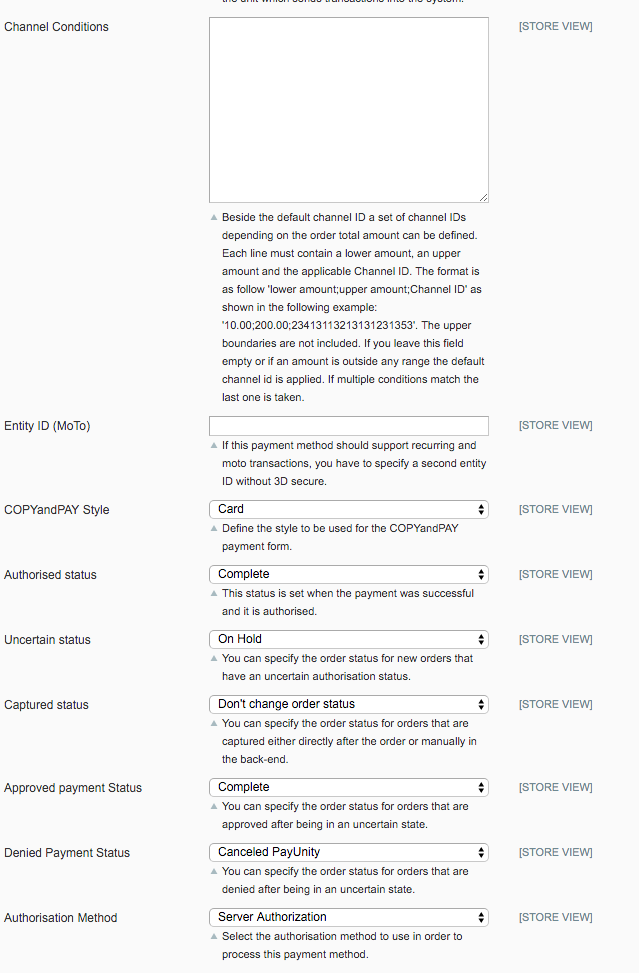
Please note that the use of the Hidden Mode comes with additional certification requirements (compare with our blog entry regarding this subject). For this reason we will no longer supply our new versions with the hidden mode. If you still use the hidden mode in you payment methods please solely use Widget. The support of the hidden mode will be terminated shortly.
2.3Configuration Webhook
In some special cases it may happen that the payment notification sent by Open Payment Platform can not be proceed by your PrestaShop shop. We recommend to configure a so called webhook in the Open Payment Platform backen under Administration > Webbhook. Please make sure that you configure the correct URL which you can find in your PrestaShop shop under Modules > Open Payment Platform > Setup.
2.3.1Configuration Webhook by Merchant
If you have to configure the the webhook on your own, you can find the webhook URL in your PrestaShop shop at Modules > Open Payment Platform > Setup . Make sure you configure it in the Open Payment Platform Backend under Administration> Webbhook. Furthermore you have to define a so called "secret for encryption" key. Make sure that you also save the same values in the corresponding fields, as on the Picture below.
Please note that only ASCII characters may be used for the generation of this key pass phrases. Please use our "secret for encryption" generator so that you do not enter invalid characters.

2.3.2Configuration Webhook by Open Payment Platform
In some Open Payment Platform accounts you can not configure the webhook by yourself. Therefor you have to provide the webhook URL to Open Payment Platform once they setup it for you, they will provide you a specific "secret for encryption" key, which you have to configure in the main module configuration of the module in your shop.
2.4Activation and Testing
When you have activated and configured the payment methods you can run a test with help from the manual Test data.
If the tests were successful you now switch the operation mode from test mode to "Live Mode" and replace the safety features above with your personal access data for the live platform. You will receive this data directly from your Payment Service Provider. Normally the USER ID etc. should be identical for the Live Mode.
3Module Installation and Update in the PrestaShop Shop
3.1Installation
At this time you should already be in possession of the module. Should this not be the case, you can download the necessary files in your customer account in the sellxed shop (Menu "My Downloads Downloads"). In order to install the module in your shop, please carry out the following steps:
- Download the plugin. The download can be found in your sellxed.com account under "My Downloads".
- Unzip the archive you have just downloaded.
- In the unzipped folder navigate to the folder "files"
- For some shops there are different versions of the plugin provided. If this is the case open the folder which corresponds to your shop version.
- Using your preferred FTP client upload entire content of this folder into the root directory of your shop. For some shops there is a specific folder containing the plugins. If that is the case upload the plugin into this folder. Make sure that the folders aren't replaced but merely merged.
- If you haven't yet done so, log back into your shop.
3.2Updates and Upgrades
You have direct and unlimited access to updates and upgrades during the duration of your support contract. In order to receive constant information about available updates we ask you to subscribe to our RSS feed that we publish for your module.
More information regarding the subscription of this RSS feed can be found under: http://www.sellxed.com/en/updates_upgrades.
We only recommend an update if something doesn't work in your shop, if you want to use new feature or if there is a necessary security update.
3.2.1Update Checklist
We ask you to strictly comply with the checklist below when doing an update:
- Always do a backup for your database and your files in your shop
- Use always a test system to test the update process.
- Wait until all the files are copied to the shop, clear the cache if there is one in your shop and then visit the configuration page of the main module so that the update process will be initialized.
Please test the update procedure first in your test shop. Our support team is able and willing to help you if you experience problems with the update process. However, if you decide to perform the update directly in your live shop there is the possibility of a downtime of the shop of more than two days depending on the availability of our support if you do not want to book our complementary support.
Depending on the version it could be that the database has to be migrated. We recommend you therefore, to perform the updates in times when the shop is not visited too frequently by your customers.
3.2.2Update Instructions
Please always read the update instruction. Those instructions can be found in the changelog. If there are no special remarks, you can proceed by just overwriting the files in your system.
4Module Configuration in the PrestaShop Shop
The configuration consists of two steps. The first step is the configuration of the main module with all the basic settings (cf. Configuration of the Main Module). During the second step you can then carry out individual configurations for each payment method . This allows for full flexibility and perfect adaptation to your processes.
Please create a backup of the main directory of your shop. In case of problems you will then always be able to return your shop to its original state.
We furthermore recommend testing the integration on a test system. Complications may arise with third party modules installed by you. In case of questions, our support is gladly at your disposal.
4.1Configuration of the Main Module
You will find the settings for the module under Modules, in the group Checkout , Open Payment Platform Integration. Install the module and open the configuration mask by clicking Configure. Enter the individual options such as described above in the configuration of the administration interface of Open Payment Platform. You will find information on the individual options directly in the additional texts in the module
If you are using a multishop setup within PrestaShop, you will need to configure the payment plugin in the main shop view first. If you do not configure the settings of the plugin in the main shop view at all, the payment will not work properly. We strongly advise you to configure your main store first before moving on to the configuration of your subshops.
4.2Configuration of Payment Methods (for PrestaShop 1.6)
After you have installed the main module you can install the corresponding payment methods. To do so you have to install the desired payment methods under Modules in the group of Payments and Gateways. You can save individual settings for each payment method and thereby optimally adapt the payment to your processes. The most central are explained in more detail in this manual.
4.3Configuration of Payment Methods (for PrestaShop 1.7)
After you have installed the main module you can install the corresponding payment methods. To do so you have to install the desired payment methods under Modules > Module Catelog. You can save individual settings for each payment method and thereby optimally adapt the payment to your processes. The most central are explained in more detail in this manual.
4.4Direct Capturing of Transactions
The option "Capture" allows you to specify if you wish to debit payments directly or if you first wish to authorise them and then debit the payment at a later point.
Depending on your acquiring contract, a reservation is only guaranteed for a specific period of time. Should you fail to debit the payment within that period, the authorisation may therefore no longer be guaranteed. Further information on this process can be found below.
It may be that settings saved in the payment modules overwrite settings saved in Open Payment Platform.
4.5Uncertain Status
You can specifically label orders for which the money is not guaranteed to be received. This allows you to manually control the order before shipment.
4.5.1Setting the order state
For each payment method you may select in which state the order should be set to depending on the booking state. This is the initial state of the order.
4.6Optional: Validation
Note: It can be that this option is not visible in your module. In this case just ignore this section.
With the option 'Validation' you can define the moment when the payment method should be made visible to the customer during the checkout process. This setting is relevant for modules where the usage depends on the customer's compliance with specific preconditions. For example, if a solvency check has to be carried out or if the payment method is only available in certain countries. In order for the credit check or address validation to also work with European characters, the charset of the "Blowfish mode" must be set to "UTF-8" for certain PSP settings.
You have the choice between these options:
- Validation before the selection of the payment method: A validation verification is carried out before the customer selects the payment method. If the customer does not fulfill the requirements, the payment method is not displayed
- Validation after selection of the payment method: The verification of the compliance occurs after the selection of the payment method and before the confirmation of the order
- During the authorisation: The validation verification is carried out by Open Payment Platform during the authorisation process. The payment method is displayed in any case
4.6.1Usage of the Integrated Multishop Functionality of PrestaShop
The payment module supports the multishop feature of PrestaShop. No further modifications are necessary. The module automatically recognizes the shop the order belongs to. In order for the multishop functionality to work, it is, however, necessary that the individual sub-shops within PrestaShop have been configured correctly.
5Settings / Configuration of Payment Methods
5.1General Information About the Payment Methods
The plugin contains the most common payment methods. In case a desired payment method is not included per default, please contact us directly.
In order to be able to use a payment method, it must be activated in your account with Open Payment Platform as well as in your shop. Information about the configuration of the payment methods can be found further above.
Below you can find important information for specific payment methods that deviate from the standard process.
5.2Information on Payment Status
For each payment method you can define an initial payment status (status for authorized payments etc.). You hereby define the payment status for each state depending on the processing type of the order (captured, authorized, etc.). It's the initial status which the order assumes. Depending on the mutation carried out by you, the status can change.
Never set the status to Pending Open Payment Platform or any similar pending status which is implemented by the module.
5.2.1Order status "pending" / imminent payment (or similar)
Orders with the status 'pending Open Payment Platform' are pending orders. Orders are set to that status if a customer is redirected in order to pay but hasn't returned successfully or the feedback hasn't reached your shop yet (Customer closed window on the payment page and didn't complete payment). Depending on the payment method these orders will automatically be transformed into cancelled orders and the inventory will be cleared (so long as the Cronjob is activated). How long this takes depends on the characteristics of the payment method and cannot be configured.
If you have a lot of pending orders it usually means that the notifications from your webserver to Open Payment Platform are being blocked. In this case check the settings of your firewall and ask the Hoster to activate the IPs and User Agents of Open Payment Platform.
5.2.2Order status "cancelled"
Orders with the status "cancelled" have either been set to that status automatically due to a timeout, as described above, or have been cancelled directly by the customer.
5.3Klarna
You can process Klarna directly viaOpen Payment Platform.In the following we will expand on the characteristics of the Klarna setup.
5.3.1Supported / Unsupported Functions
The module does not support the following functions:
- You can not create or change any orders in the backend of PrestaShop .
- Partial activation and refunds can only be performed through the backend of Open Payment Platform () Full activation and full refunds can be performed directly inside PrestaShop. For more information visit the Chapter around transaction management.
Please make sure that you never modify or edit any Klarna transaction in your PrestaShop backend.
The remaining functions are supported by the module. In the following you will find a description of the most important functions.
5.3.2Set Up / Configuration of the Payment Method
Activate the payment method as usual. Please note the following regarding the installation:
5.3.2.1Displayed Name of the Payment Method
You may change the displayed name in the frontend via title. Please use the title Invoice. Furthermore, you can define whether the Klarna logo is visible to your customers in the frontend via Display Logo.
5.3.2.2Description of the Payment Method
You may change the description of the payment method in the frontend via description. Please make sure you display the following description in your frontend: "Pay within 14 days".
5.3.2.3Select Authorization Method
We recommend to set Server as authorization method. In this case you will not be redirected to the payment page of Open Payment Platform.
5.3.2.4Klarna Merchant ID
In the payment method you can also define the Klarna Merchant ID (EID). You will either find this in your Klarna account or ask for it directly at Open Payment Platform.
5.3.3Canceling the Invoice
How to cancel invoices will be explained below in the chapter Activating / Canceling Orders. For further questions please refer to this section.
5.3.4Full Activating Invoices
For more information visit the Chapter around transaction management.
5.3.5Partial Refund and Partial Activation
Partial refunds and partial activations can only be done through the BIP of Open Payment Platform.
5.3.6On Hold Orders (Pending)
Pending orders are not supported by the module. In order you want those to be handled correctly by the system, please leave the field "Status Check interval" blank in your BIP. Please contact Open Payment Platform to make this setting.
5.3.7Testing
In order for you to test the payment method Klarna you will need specific test data. But first make sure the the operation mode is on test and the test mode is on external.
You will find the official test data for Klarna directly in the developer portal via this link: https://developers.klarna.com/en/de+php/kpm/test-credentials.
5.3.8Payment fees
If you want to charge payment fees for a specific payment method, feel free to use the compatible payment fees modules. Those fees are directly transmitted to Klarna.
Please make sure to not charge payment fees within the Open Payment Platform BIP Backend. Please use exclusively the compatible modules as described above.
6The Module in Action
Below you will find an overview of the most important features in the daily usage of the Open Payment Platform module.
6.1Capturing of Orders
The transaction management between your shop and Open Payment Platform is not synchronized. If you capture payments with Open Payment Platform, the status in the shop will not be updated and a second capturing in the shop is not possible.
In order to be able to capture orders you must make sure that you have set the option 'Capturing' to 'deferred' in the payment method configuration.
Transactions can be captured in different ways. The different options are explained below.
6.1.11. Via Orders > Open Payment Platform Transactions
You can view all transactions in the transaction table under Orders > Open Payment Platform transactions"
Open the order and then click on the small magnifying glass in den transaction information overview. By clicking Capture button, you get into the following context.
Enter the amount and quantity that you wish to capture from the customer's authorization. By clicking Capture a direct capturing of the order occurs with Open Payment Platform.
6.1.22. Capture the transaction through the order and the Open Payment Platform transaction tab
Open the order and then click on the small magnifying glass in the Open Payment Platform transactions overview.
A window will then drop down. Enter the amount of your choice that you wish to capture from the customer's authorization. By clicking Capture a direct capturing of the order occurs with Open Payment Platform.
By clicking Capturing button, you get into the following context.
Enter the amount or quantity choice that you wish to capture from the customer's authorization. By clicking Capture a direct capturing of the order occurs with Open Payment Platform.
6.2Useful Transaction Information on the Order
In each order, processed via our module, you can find an overview of the most important information about the transaction as well as a transaction history.
6.3Place Orders in the backend of PrestaShop
With the PrestaShop payment module you can place orders and capture the payment directly in the shop; so called Mail Order / Telephone Order (MOTO).
- Go to the order overview and click on "Create New Order"
- A window will open up. Search for the customer for whom you wish to place an order or manually create a new customer
- Search for the product in question and add it to your cart
- Before clicking Create Order, select the payment method
- Depending on the authorization method that you have saved for the selected payment method, you will either be redirected to the Payment Page of Open Payment Platform or the mask for the credit card will appear such as in the image below. Enter the customer's credit card information and click Debit the customer.
6.4Refunds
You can refund already captured transactions and automatically transmit them to Open Payment Platform. In order to to so, open the order. You have two alternatives for refunding the money. Either you use the refund tool or the partial refund process of PrestaShop. Both processes are explained in this passage.
6.4.11. Transactiontable via Orders > Open Payment Platform transactions
You can view all transactions in the transaction table under "Orders > Open Payment Platform transactions"
Open the order and then click on the small magnifying glass in den transaction information overview. By clicking Refund button, you get into the following context.
Just like for the capturing, you open the order and click on the magnifying glass next to the order of your choice. Enter any refund amount of your choice in the field provided for this purpose. By clicking refund the refund request will directly be sent to Open Payment Platform and the specified amount will be credited on the customer's credit card.
Please note that you can't refund more than 100% of the original amount.
6.4.22. Refund the transaction through the order and the Open Payment Platform transaction tab
Open the order and then click on the small magnifying glass in the Open Payment Platform transactions overview.
By clicking Refund button, you get into the following context.
By clicking Refund button, you get into the following context.
Enter any refund amount of your choice in the field provided for this purpose. By clicking refund the refund request will directly be sent to Open Payment Platform and the specified amount will be credited on the customer's credit card.
Please note that you can't refund more than 100% of the original amount.
6.4.33. Refund with the PrestaShop internal/default functionality.
You can carry out refunds with the Partial Refund Process of PrestaShop based on the product quantity. After having opened the order, click on Partial Refund in the top right corner. The browser will scroll down and you can specify the amount of the partial refund. If you wish, you can also directly add the item(s) to the stock. In order to do so, click on the corresponding check-box. By clicking Partial Refund, a new window opens up.
In the following window, click 'Yes' in order to transmit the refund to Open Payment Platform and the specified amount will be credited to the customer's credit card.
Please note that you can't refund more than 100% of the original amount.
Executing a refund will not change the status of the order.
6.5Usage of the Alias Managers / Token Solution
With the Alias Manager, your customers can securely save their credit cards with Open Payment Platform for later purchases. You can enable this by activating the option "Alias Manager" in the configuration of the Payment Method. The customer can then choose from his or her saved credit cards without having to re-enter all the details.
The usage of the Alias Managers requires the activation of the correct option with Open Payment Platform. To do so, please contact the support directly.
6.6One Page Checkout
The checkout of PrestaShop can be modified and reduced to one step. Our module support the standard OnePageCheckout of PrestaShop. No guarantee can be made in regards to the compatibility with third party modules.
You can activate the standard checkout by going to Preferences, Orders. Choose the option 'one-page checkout' in the drop-down menu for Order-process type.
6.7Setting up Cron Job
In order to activate the time-controlled functions of the plugin (such as update service, deleting pending orders, etc.) set up a time-controlled request in your hosting provider backend using the URL which you will now find via Modules > Open Payment Platform in the tab "Extended Information". Invoking it regularly will trigger the actions.
Here we suggest you use a Cron Engine like for example EasyCron. This allows you to open the file ( URL ) with an external service.
7Testing
Before switching from test to live mode it is important that you test the module extensively.
Do not forget to switch the operating mode from test to live after having successfully tested the module.
7.1Test Data
In the following section you can find the test data for the various payment methods:Card number 377777777777770 Expiry Date 12/2020 CVC 123 | No 3D Secure |
Card number 375987000000005 Expiry Date 12/2020 CVC 123 | 3D Secure |
Card number 5555555555554444 Expiry Date 12/2020 CVC 123 |
Card number 5019717010103742 Expiry Date 12/2020 CVC 123 |
Card number 36961903000009 Expiry Date 12/2020 CVC 123 |
IBAN AT152011128161647502 BIC GIBAATWWXXX | Austria (AT) |
IBAN DE23100000001234567890 BIC MARKDEF1100 | Germany (DE) |
IBAN ES9121000418450200051332 BIC CAIXESBBXXX | Spain (ES) |
Card number 6011587918359498 Expiry Date 12/2020 CVC 123 |
IBAN AT152011128161647502 BIC GIBAATWWXXX | Austria (AT) |
IBAN DE23100000001234567890 BIC MARKDEF1100 | Germany (DE) |
IBAN ES9121000418450200051332 BIC CAIXESBBXXX | Spain (ES) |
Card number 3541599999092431 Expiry Date 12/2020 CVC 123 |
| Klarna (Approved) | |
| Klarna (Denied) | |
| Klarna (Pending -> Approved) | |
| Klarna (Pending -> Denied) |
Card number 6799851000000032 Expiry Date 12/2021 CVC 123 |
Card number 5454545454545454 Expiry Date 12/2021 CVC 123 | No 3D Secure |
Card number 5212345678901234 Expiry Date 12/2021 CVC 123 | 3D Secure |
Card number 4200000000000000 Expiry Date 12/2020 CVC 123 | No 3D Secure |
Card number 4012001037461114 Expiry Date 12/2020 CVC 123 | 3D Secure |
Card number 4000000000000010 Expiry Date 12/2021 CVC 123 | 3D Secure 2.0 |
Card number 4822000000000000003 Expiry Date 12/2020 CVC 123 |
8Errors and their Solutions
You can find detailed information under http://www.sellxed.com/en/faq. Should you not be able to solve your problem with the provided information, please contact us directly under: http://www.sellxed.com/en/support
8.1Modul Performance
Depending on your server specs it could be that the module results to performance issues in your store. In this case we suggest to do the following:
- Deactivate the PrestaShop Cache. We often saw already better results when the cache was disabled.
- Deactivate the PrestaShop displayBackOfficeHeader hook. For this go to > Modules > Hooks > and disable the hook Open Payment Platform Integration under the displayBackOfficeHeader Menu.
In case you want to undo the changes above you will need to re-install the base module again.
8.2The Referrer URL appears in my Analytics Tool
When a customer and the notification are redirected via Header Redirection, the Open Payment Platform Referrer URL might appear in your Analytics Tool thus hiding the original traffic source. However, most Analytic Tools are able to minimize this problem.
In case you are using Google Analytics as reporting tool, this step by step guide may help you to exclude the URLs: under bullet point 4.
9Compatibility with Third-Party Plugins
The plugins listed below are compatible with our payment modules and allow you to handle certain tasks in an easier way.
9.1Fee's and discount's within PrestaShop
To configure a Open Payment Platform payment gateways based fee and discount you will need the following 3rd-Party plugin.
9.2Birthday and gender in PrestaShop
For certain payment service providers it is necessary to check the birthday and the gender of a customer. PrestaShop does not check this by default. Information on how to enable those checks can be found here:
10Error Logging
The module will log different unexpected errors or information depending on the configured level. If there is any issue with the module, this log can help identify the cause.
10.1Log Levels
You can configure the log level in the Open Payment Platform settings.
- Off: Nothing is logged. (Default)
- Error: Logs unexpected errors only.
- Info: Logs extended information.
- Debug: Logs information helpful for debugging.
10.2Log Location
In PrestaShop 1.5 the FileLogger is used. The log file is stored in the log folder of your installation. Please make sure the path exists and it is writable by the webserver. (Default Path: {shopRootDirectory}/log/)
In PrestaShop 1.6 and newer the default PrestashopLogger is used and are therefore stored in the database. The log message are visible in the PrestaShop backend under the menu item Advanced Parameters > Logs.
11Advanced Information
This section of the manual is for advanced usage of the module. The content is for advanced users with special requirements. Everything in this section is optional and not required for the daily usage of the module.
11.1Transaction Object
This section describes how to extract information from a transaction, if you need it for further processing. E.g. you require more information of the transaction for further processing an order in your ERP system.
The code snippets in this section assume your script resides in the root folder of the shop with the default shop folder structure.
require(dirname(__FILE__).'/config/config.inc.php');
require_once _PS_ROOT_DIR_.'/modules/oppcw/oppcw.php'; require_once _PS_ROOT_DIR_.'/modules/oppcw/lib/OPPCw/Entity/Transaction.php';
$transactionById = OPPCw_Entity_Transaction::loadById($transactionId); $transactionObject = $transactionById->getTransactionObject();
$transactionsByOrderId = OPPCw_Entity_Transaction::getTransactionsByOrderId($orderId);
foreach($transactionsByOrderId as $transaction){
$transactionObject = $transaction->getTransactionObject();
//Do something with each object
}

